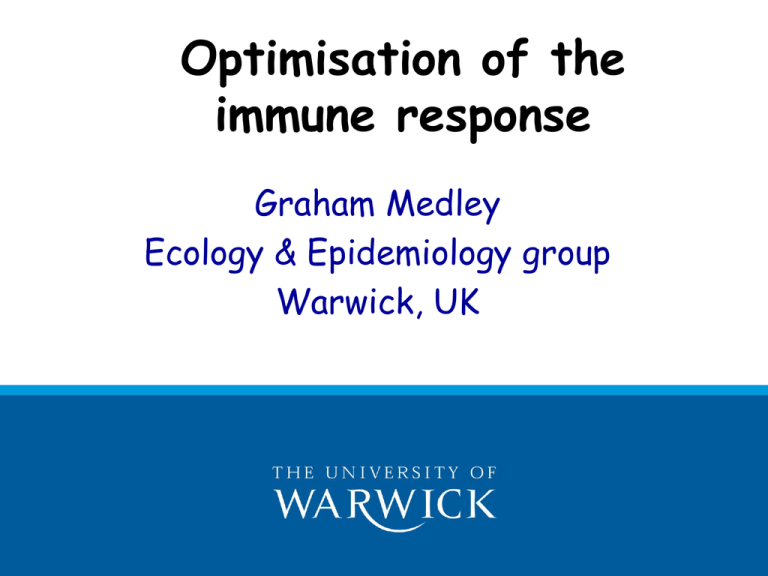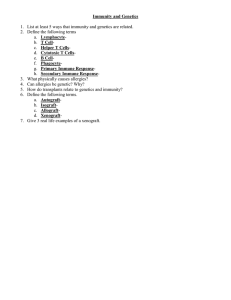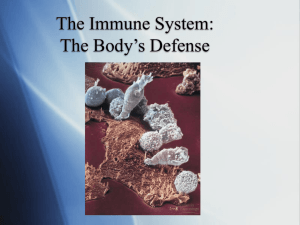Optimisation of the Immune Response
advertisement

Optimisation of the immune response Graham Medley Ecology & Epidemiology group Warwick, UK Age-dependant Intensity Macroparasite Immunity Models • Immune response is a function of history of exposure – Memory, M(a) – Immunity is a non-linear, increasing function of M(a) • But why? – If it takes hours to respond to a virus, why does it take years to respond to macroparasites? – Hosts should be more concerned with present & future than past a M a ~ Ps e a s ds 0 Also applies to other chronic infections, e.g. malaria. As intensity of transmission (immigration rate) increases: >> the overall intensity of infection increases >> the age at peak intensity decreases >> there is a “change” at sexual maturity Lusingu et al. , Malaria Journal 2004, 3:26 What is the Immune System for? • Hosts use their IS to maximise survival and reproduction – Possibly tautological, but true – The IS does not have the sole aim of killing parasites • IS is constrained by other physiology • Persistence of infection does not immediately imply parasite cunning or immunity failure • Generate questions about the functions of immunity – and therefore the mechanisms that might be expected Constraints to Immunity • IS is expensive in terms of limited resources (energy & protein) – Other processes that enhance “fitness” • E.g. growth & reproduction – Many physiological processes constrained by “minimum energy” or “minimum protein” • IS is dangerous – Autoimmune disease • Hosts may choose to devote resources to things other than immunity – especially if infection is rarely immediately lethal and continuous (macroparasites) – not if infection will be lethal if uncontrolled (viruses) Immunopathology • For many infections, the immune response “causes” the disease – Respiratory syncytial virus • Eosinophilia creates the clinical disease • Ablate eosinophilia & mice die without symptoms – Schistosomiasis • Circulatory failure due to granuloma formation around eggs embedded in liver – Ascaris suum • Single large dose leads to explusion • Same dose trickled leads to establishment & little pathology Adaptive Immunity • Adaptive to overcome pathogen adaptation – Adaptive to host requirements: protein & energy • Also adaptive to survival / reproduction context – Nutrition (resources) • Malnourished hosts experience more disease – Gender & Social Status • Males & females do not have same priorities • Hormonal influence (effect of testosterone) – Age • Priorities change • Immuno-modulation of parasite burden Trickle Exposure: Dose 30 25 20 15 10 5 30 0 0 6- 21- 41- 61- 10 30 50 70 >80 25 20 15 10 5 0 0 6- 21- 41- 61- 10 30 50 70 >80 Natural Exposure: Duration 30 25 20 15 10 5 30 0 0 6- 21- 41- 61- 10 30 50 70 >80 25 20 15 10 5 0 0 6- 21- 41- 61- 10 30 50 70 >80 Maternal Exposure 14 12 10 8 6 4 14 2 12 0 0 -10 -20 -30 -40 -50 -60 10 8 6 4 2 0 0 -10 -20 -30 -40 -50 -60 Adaptive Immunity • Exposure modulates infection so that prevalence increases and maximum burdens decrease – Variability is decreased • Immune system is the modulator • Exposure results in “shuffling” of individual burdens within a group of hosts – No expulsion Model of Resource Allocation • How should hosts devote resources between immunity and other functions as they age? • Simple model of infection, immunity and fitness • Single host over age • Constrained optimisation problem Macroparasites • Within-host parasite population, p p p – Immigration-death process • Parasites do not reproduce within the host – Immigration & death rates of parasite depend on level of immunity p e 3 I e p 3I Simple Model : Immunity • Resource input is constant: R • Partitioned into immunity (I), growth & reproduction • Resources devoted to immunity are dependent on – parasite population – individual host dependent parameter, (a) p I R 1 p Simple Model : Host • Fixed age at maturity, w • Investment in growth during immaturity to increase size, g • Survival to any age is dependent on relative size and current parasite burden determine survival, s • Reproduction is dependent on size and resources available g R I g (1 g ) aw g s 0 1 1 g max m R I g a w p s Reproductive Value, RV • Maximum age, L • Expected future reproductive success – survival is related to size and parasite burden – reproductive effort is related to size and resources (not used for parasite resistance) • Maximise fitness as a trade-off between – reducing parasites now • less likely to die – and growing to be bigger • less likely to die in the future & reproduce more L V s (a)m(a)da 0 Model Structure • Differential equations – Three equations ( g, p, s ) – Solved & maximised numerically • IBM stochastic simulations • Unscaled – Redundancy: pathogenicity ~ immigration – Quantitatively meaningless Optimisation Problem • Aim is to optimise the host fitness by varying proportion of resources devoted to immunity, (a) • Initially assume constant throughout life – RV at birth maximised Effect of control parameter, 50 40 4 Parasites, p Repro. Value 5 3 2 20 10 1 0 0.5 0 0 1 1 1 0.8 0.8 0.6 0.4 0.2 0 0 10 20 30 20 30 Age Survival, s Size, g 30 0.6 0.4 0.2 10 20 Age 30 0 0 10 Age Immunity is always “sub-optimal” • Reproductive value is optimised at when resources devoted to immunity are intermediate – There is an “optimal” parasite burden • Given continuous (constant) immigration and constant resources • Optimised values change with conditions – Changing immigration & resource level… Dependence on 0.35 12 0.3 10 0.25 8 opt p opt 0.2 6 0.15 4 0.1 2 0.05 0 0 50 Immigration, 100 0 0 50 Immigration, 100 Dependence on resources 0.35 50 45 0.3 40 0.25 35 30 opt p opt 0.2 0.15 25 20 15 0.1 10 0.05 5 0 0 1 2 Resource, R 3 Medley, G.F. (2002) Parasitology 125 (7), S61-S70 0 0 1 2 Resource, R 3 Age-related immunity • Allow (a) – Linear segments – RV calculated throughout life • Amounts to maximising at each age • “Dynamic programming” approach: each (a) depends on the others • All other parameters (R, ) constant with age Effect of Resources R 50 45 40 Parasite Burden 35 30 25 20 15 10 5 0 0 R=0.5,1,1.5,2 5 10 15 Age 20 25 30 Effect of Resources R 0.5 0.45 0.4 0.35 (a)opt 0.3 0.25 0.2 0.15 0.1 0.05 0 0 R=0.5,1,1.5,2 5 10 15 Age 20 25 30 Effect of Immigration 0.4 0.35 0.3 0.25 0.2 0.15 0.1 0.05 0 0 =5,25,50,100 5 10 15 Age 20 25 30 Age-Related RV Effect of Immigration 12 10 Repro. Val. 8 6 4 2 0 0 =5,25,50,100 5 10 15 Age 20 25 30 Effect of Immigration 80 70 Parasite Burden, p 60 50 40 30 20 10 0 0 =5,25,50,100 5 10 15 Age 20 25 30 Effect of Immigration 14 12 Parasite Burden, p 10 8 6 4 2 0 0 5 10 Age =5,25,50,100 15 Age-dependant Intensity Results • Maximum age span (30) – Immunity reduced as death approaches – No value in compromising reproduction for survival • Reproductive maturity – Big change in immunity • Emphasise growth during immaturity • Emphasise survival in maturity – Optimal strategy is to increase risk of death in order to be “fitter” when older Mutapi et al. – S.haematobium BMC Infectious Diseases 2006, 6:96 Peak Shift 14 13 Maximum p ( a<15 ) 12 14 11 10 13 9 7 20 30 40 50 60 70 Immigration, 80 90 100 110 5.5 Maximum p ( a<15 ) 12 8 11 10 9 5 Age at Maximum ( a<15 ) 4.5 8 4 3.5 7 1 3 2.5 2 1.5 1 20 30 40 50 60 70 Immigration, 80 90 100 110 1.5 2 2.5 3 3.5 4 Age at Maximum p 4.5 5 5.5 1.4 1.2 100 k Frequency 150 50 0 0 1 0.8 200 400 Parasite burden, p 0.6 0 600 20 40 60 Mean Parasite Burden 80 0.5 g 1 3 1 10 0.8 2 10 g p 0.6 0.4 1 10 0.2 0 0 0 10 2 10 p 10 0 500 hosts with uniform random R, and β; (constant ) Conclusions • IR in host context – Reproduces observed phenomena: • • • • Age-related intensity Peak shift Heterogeneity Predisposition Speculations • What we can expect the IS to do – Dynamic • Mechanisms for continual monitoring of damage, changes in parasite population size, physiological state • Effectiveness (e.g. B-cell affinity maturation) – Defined by host context (age, nutrition etc) • Mechanisms for interaction with remainder of physiology • Molecules that operate in both, e.g. leptin – Learning • Adaptive immunity is a sensory system – Controls innate immunity – Determines immune response in context, e.g. effects of age vs HLA in HIV Proportion surviving Survival against age at HIV seroconversion 1.0 0.8 2.5 0.6 10 0.4 20 0.2 40 30 70 0.0 0 5 60 10 Years since infection 50 15 Time from HIV-1 seroconversion to AIDS and death before widespread use of highly-active antiretroviral therapy A collaborative re-analysis. Cascade Collaboration. Lancet 2001:355 11311137 Is Death a Failure? • Death does not immediately imply immune system failure – Risking death to be bigger • Apoptosis – Cell death to kill intracellular parasites – Do eusocial insects die to kill their parasites & protect their sisters? • Since infection transmits least some immunomodulation is not optimal for individual – Hand-waving arguments involving inclusive fitness Individuals Populations • Infection rate depends on sum of individual parasite burdens • Resources are limiting – Competition for resources: dependent on size? • Dynamic game – Individual strategies determine others (and own) conditions • Real time optimisation of individual IR – High “discount rate” (e.g. random death) will emphasise current immunity • Immuno-ecology




